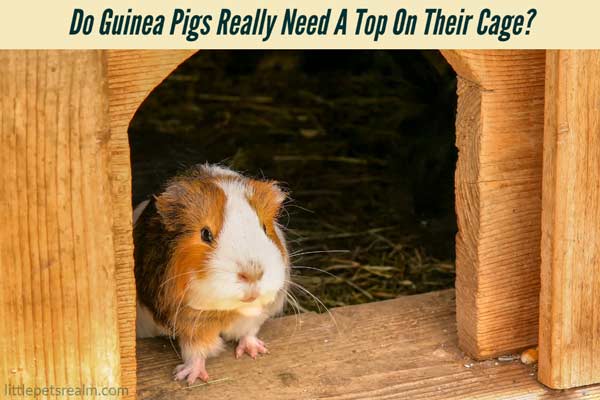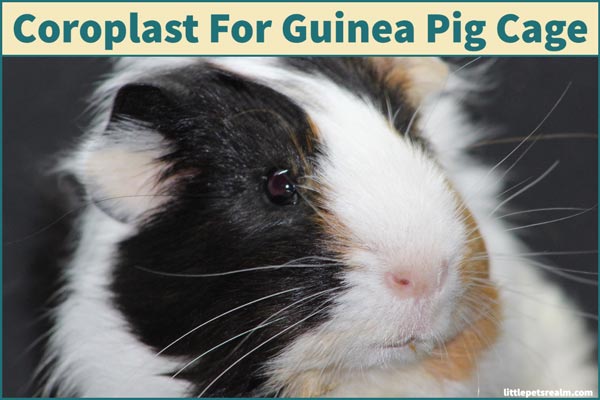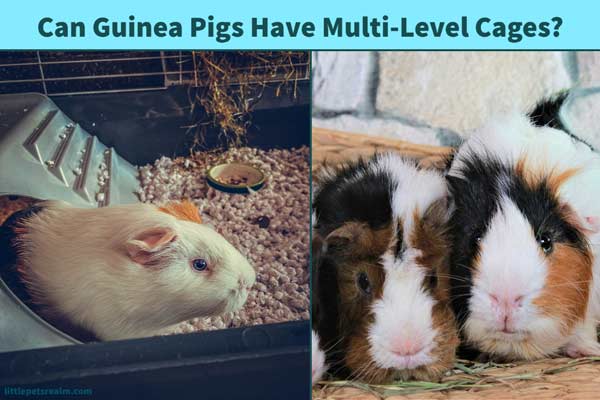After buying an open-top guinea pig cage or even before buying it, a common question people ask is, Should you cover a guinea pig cage at night?
You shouldn’t cover guinea pigs’ cages at night as it can be uncomfortable for them and cause trouble breathing. However, you may need to put a cover in a special circumstance such as protecting them from other pets at your home. In that case, use a wire mesh top that’s latched carefully and allows sufficient airflow.
If you have a cat or a dog, it might be necessary to enclose the top at night. They may not be so friendly sometimes to your piggies.
Another situation is when you put an outdoor cage.
In this article, I have discussed when and how to cover the guinea pig cage at night. Also, know about the advantages and disadvantages of covering the cage.
Table of Contents
Why shouldn’t cover the guinea pig cage at night?
If you cover the guinea pig cage at night, it can cause some serious problems. Here are some causes for which you shouldn’t cover the cage at night.
Can be stressful
Guinea pigs can be stressed so easily. So, if they aren’t used to the blanket or the cover you are using, it can be stressful for them.
They might start chewing on the cage bars out of boredom or nibble on their own fur out of stress.
This can lead to health problems like hair loss, gastrointestinal problems, and even depression.
Try to avoid any condition that can cause them to stress out as it can create more complications in the future for them. If you need to use a cover, allow them to get used to it.
May affect their breathing
You may want to cover the cage for their good, may like to use a blanket or other stuff to protect them from cold weather.
It would be really uncomfortable for your guinea pigs to stay in a dark and enclosed space. They might feel suffocated and have trouble breathing.
Use a thin blanket and use proper technique to keep the cage warm so that they can breathe freely and sleep well.
Check out my article on using blankets for guinea pigs.
Being active at night
Another reason is that guinea pigs are active at night. They don’t sleep the whole night like us. They sleep all day and night, but it’s not continuous. It’s almost like taking a nap.
So, covering their cage would make them really bored and stressed out.
They need to run, play, and explore their surroundings. If you cover their cage, they would feel trapped and frustrated.
It is really important to give them enough to move around freely.
Check out large cage ideas for guinea pigs.
May cause the sleeping problem
As guinea pigs love to stay in open space, covering up the cage suddenly may cause them not to sleep.
However, piggies are prey animals and love to sleep in dark and quiet places. So, they can get used to a covered cage easily if the room is dark.
May change their mood and food habits
A covered cage can stress guinea pigs out which can also affect their mood and change their food habits. This is bad for their overall health.
They may stop eating or drink less water which can lead to dehydration.
Can’t escape or climb out of the cage
Naturally, guinea pigs cannot climb like other rodents and cannot escape the cage if the sidewall is sufficiently high.
Learn more about guinea pig climbing and cage height.
When do you need to cover the guinea pig cage at night?
Covering a guinea pig cage at night is important to create a safe and comfortable environment for your guinea pig. At night, the temperature can drop and your little pig can get cold. A cover will help to keep the temperature inside the cage stable.
In addition, a cover can provide extra darkness, which can help your little pig to sleep. They sleep with their eyes open occasionally, so it is important to make sure their cage is dark and quiet.
You can also cover the cage will also help to keep out drafts and protect the guinea pig from predators.
How do you cover the guinea pig cage at night?
You can buy cages that come with a cover, or you can make your own.
To cover the guinea pig cage at night, first, make sure the temperature in the room is warm enough. They should be kept at a temperature of between 65 and 75 degrees Fahrenheit.
Next, turn off any lights in the room and close the curtains or blinds. You can then put a cover over the cage.
Make sure that the cover is not too heavy and that there is still some airflow. To keep the cover in place, use clothespins or weights.
Lastly, check on your guinea pig periodically to make sure they are doing okay.
Benefits of covering the guinea pig cage
-Keeps the cage temperature stable in winter
-Provides extra darkness
-Keeps out drafts
-Protects from predators
Drawbacks of covering the guinea pig cage
-Can be stressful for guinea pigs
-May affect their breathing
-Might cause the sleeping problem
-May change their mood and food behavior
Things to consider when covering the guinea pig cage
Let’s look at the things you should consider when covering the guinea pig cage.
The cover should be breathable.
You should use a cover that is breathable. This is because guinea pigs need to breathe and they can’t hold their breath for a long time.
You can use a light blanket or sheet to cover the cage. Make sure that the fabric is not too thick and that there are holes for air to circulate.
You should also make sure that the cover is not too heavy. This can stress out your little pig and make it difficult for them to move around.
There should be enough airflow.
There should be enough airflow so that a guinea pig can breathe. To keep the cover in place, you can use zip ties or clothespins, and leave enough room for air to circulate.
The cover should be easy to remove.
You should be able to remove the cover easily in case a guinea pig needs to come out. Otherwise, you will have to take the whole cage apart to get to them.
You should also be able to put the cover back on easily so that your little pig can go back in.
You should also consider the size of the cover.
If you use a wire mesh cover, it can be big enough to cover the entire cage. But, if you put a blanket or other materials, you shouldn’t use a big one and shouldn’t cover the entire cage. Otherwise, it will block the ventilation and cause suffocation for piggies.
The cover should be light-weight
You should use a cover that is not too heavy. Otherwise, taking it off and putting it back on will be tough. In addition, a heavy cover can stress out a guinea pig.
You should also consider the material of the cover.
The cover should be made of breathable material. Otherwise, the guinea pig may have difficulty breathing. If you need to put a cover, use cage grids.
The cover should be washable.
You should use a cover that is washable. Otherwise, you will have to replace the cover often.
Check on your guinea pig periodically
You should check on the guinea pig periodically to make sure they are doing okay. Make sure that the temperature in the room is not too cold or not too hot and that the little pig has enough space to move around.
How to cover the guinea pig cage?
First of all, choose the right type of cage cover that is breathable, or lightweight. A wire grid is preferable for guinea pigs.
Then, put the cover over the cage and make sure there are holes for air to circulate.
You can use clothespins or weights to keep it in place. If you are using cage grids, you can use zip ties.
When should you remove the cover?
You should remove the cover when your guinea pig is awake and active. Guinea pigs need to exercise and explore their environments.
Covering the cage all the time can limit their movement and cause them to become bored.
In addition, you should remove the cover when the temperature inside the cage becomes too warm. Piggies can overheat easily, so it is important to make sure the cage is well-ventilated.
You can also remove the cover when you are cleaning the cage or feeding your guinea pig.
When do you need a cage cover for the guinea pig?
Covering a guinea pig cage is important for several reasons.
First, it helps to provide your guinea pig with a sense of security. A little pig that feels secure is more likely to be calm and docile, making it easier to handle.
Secondly, a cover can help to keep a cage clean by preventing items from being thrown or blown into the cage.
Finally, a cover can help to protect the little pig from excessive light and noise.
If you cover your little pig cage at night, make sure that there is ventilation so that the piggy can breathe easily. Covering a guinea pig cage is an important part of responsible pet ownership.
What type of cover should you use for the guinea pig cage?
You can use a variety of materials to cover your guinea pig cage at night. A sheet, towel, or blanket can all be used. You will want to make sure that the material you choose is breathable and not too heavy. A thin cotton sheet is a good option.
You can also buy specially made cage covers that are designed to allow airflow while still providing darkness.
You can use cage wire grid covers that attach to the cage and have a flap that can be opened or closed. These covers are easy to use but may not provide enough darkness for some piggies.
You can also make your own cage cover by cutting holes in a dark-colored sheet and attaching it to the cage with clothespins, zip ties, or weights.
What should you not use to cover the guinea pig cage?
Firstly, you should not use plastic to cover your guinea pig cage. Plastic is not breathable, so it can cause them to overheat. In addition, plastic can make it difficult for the guinea pigs to see and hear, which can be stressful. Plastic can give off fumes that can be harmful to them.
Secondly, you should not use a heavy blanket or quilt to cover a guinea pig cage. A heavy covering can cause them to overheat, and it can also be difficult to remove if your little pig needs to exit the cage.
Finally, you should not use anything that is sharp or pointy to cover a cage. This can include items like pins or needles. Covering your little pig cage is an important part of responsible pet ownership, but you should be sure to use the right materials.
Conclusion
You don’t need to put a cover on the guinea pig cage because they can’t climb out of the cage. Moreover, they need enough ventilation, and covering a cage can be uncomfortable and stressful for them. However, if you need to cover a cage to protect them from predators or other pets, you can use a cage cover with wire grids and adequate spacing.
FAQ about covering guinea pig cage
Can you cover a guinea pig cage with a blanket?
You can use a blanket to cover a guinea pig cage. But, you have to make sure that it’s thin and breathable and you don’t cover the entire cage to allow ventilation.
Is it bad to cover a guinea pig cage?
Usually, it’s not required to cover the guinea pigs’ cages because it might be stressful for them. However, you may need a cage cover if you want to protect your piggies from other pets in your home. If you use a cover, make sure it has enough space for air to circulate.
Is it safe to cover the guinea pig cage at night?
It’s okay to cover the guinea pig cage at night as long as you use a breathable material and leave enough space for ventilation. However, if you don’t have other pets, you don’t need to cover the cage at night.
Do guinea pigs like to be covered?
Some guinea pigs may feel safer and more secure when their cage is covered. However, some of them may find it stressful. It’s best to observe your guinea pig’s behavior to see if they prefer a covered cage. If they seem stressed, you can try removing the cover.
However, even if you use a cage cover, you should put something to allow them to burrow under them such as fleece or hide inside like a hide house.
What if your guinea pigs try to escape the cage?
This is the first concern as you may think piggies may jump or climb out of the cage at any time.
But, you shouldn’t get worried as they are so adorable and can’t escape the cage. They may try to escape if they feel danger, but they can come out of the cage as their body doesn’t allow it, that’s unfortunate for them
They can climb up to 10 to 20 cm only. In rare cases, it can be a bit more.
So, if you use a cage with adequate measurements, nothing to worry about.

I am Pallab Kishore, owner of Little Pets Realm. I share important tips, advice and answer all the queries to solve various problems about small pets such as guinea pigs and hamsters on this website.



